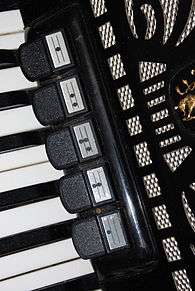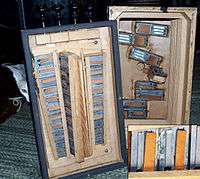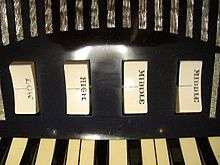Accordion reed ranks and switches


A reed rank inside accordions refers to a single full set of the reeds that are the means to achieve the instrument's sound range. These reed ranks are located in the reed chamber. Most accordions to this date typically have anywhere between 2-4 reed ranks on the treble side and 3-5 reed ranks on the bass side. These can usually be selected individually or combined in various ways to provide a range of different timbres, by use of switches arranged by register from high to low. More of the top-line expensive accordions may contain 5-6 reed blocks on the treble side for different tunings, typically found in accordions which stress musette sounds.
How many reeds an accordion has is defined by a method that looks like a fraction. For example, a 4/5 accordion has 4 reeds on the treble side and 5 on the bass side. A 3/4 accordion has 3 reeds on the treble sides and 4 on the bass side.
Reed ranks are classified by either organ 'foot-length' stops or instrument names. Visually, they each have a fixed dot in a three-level icon as displayed in the photo on the right and tables below. These icons display when more than one reed-rank is in use.
Register stop classifications
The pitch of a single bank of reeds is traditionally defined in a similar manner to the organ stops of a pipe organ. A bank that sounds at unison pitch when keys are depressed is called 8'; (pronounced "eight-foot") pitch: alluding to the length of the lowest-sounding organ pipe in that rank, which is approximately eight feet. For the same reason, a stop that sounds an octave higher is at 4' pitch, and one that sounds an octave lower than unison pitch is at 16' pitch.
Most reed registers are normally in relative octave tuning, but rarely, some instruments have a reed bank tuned to a Fifth relative to the 8' stop (or some octave of that). This is a similar arrangement to stops for a pipe organ.
| Icon | Classification | Description |
|---|---|---|
| |
4' stop | This is the highest reed rank. Not all accordions will have this reed rank. It is an octave above the 8' reference stop, and mostly serves to add color to the heavier reeds. Listen (MP3) |
| |
8' stop | This is the basic middle reed rank. It is the reference which is first tuned, then serves as a base for tuning the others. In Italian, it is called the clarino. Listen (MP3) |
| |
8' stop | This is another middle reed rank, the upper tremolo rank.[1] It is usually tuned slightly higher than the basic middle reed rank.[2] Not all accordions may have this reed rank. |
| |
8' stop | This is another middle reed rank, the lower tremolo rank.[1] It is usually tuned slightly lower than the basic middle reed rank.[2] Usually only included on special "musette accordions". |
| |
16' stop | This is the lowest and deepest-sounding reed rank in the reed chamber. It is one octave lower than an 8' reed rank. Listen (MP3) |
Register switches
Register switches select combinations of reed ranks to produce contrasting timbres. Most accordions have "automatic" or "pre-set" switches, similar to voice selection on an electronic keyboard, or to a preset combination action in a pipe organ. These switches control which reed ranks are enabled (opened up) or disabled (closed off): some switches enable a single reed rank, others enable several simultaneous reed ranks. Unlike individual organ stops, only one combination is active at any given time.[3]
Here are a few examples of right-hand manual switches on a typical large accordion[4] (smaller instruments with fewer reed banks may have fewer switches or even none):
| Icon | Nickname | Register stop(s) in use | Sound |
|---|---|---|---|
| |
Piccolo | 4' | High, thin, reedy tone. Listen (MP3) |
| |
Clarinet | 8' | A round tone, relatively light in upper harmonics. Listen (MP3) |
| |
Bassoon | 16' | A low, full, smooth tone. Listen (MP3) |
| |
Oboe | 4'+8' | A thin, bright tone Listen (MP3) |
| |
Violin | 8'+8' | A wavering "tremolo" or "chorus" sound from detuned reeds, analogous to the Voix céleste organ stop. Listen: Dry-tuned (MP3), Wet-tuned (MP3) |
| |
Musette (Imitation) | 4'+8'+8' | Actually an imitation musette sound. Found in most accordions. (Compare to the authentic three-reed musette, listed next.) Listen (MP3) |
| |
Musette (Authentic) | 8'+8'+8' | A strong and distinctive tremolo sound, found in special "Musette accordions". Listen (MP3) |
| |
Organtype (Organ) | 4'+16' | A full yet hollow, slightly reedy quality. Listen (MP3) |
| |
Harmonium | 4'+8'+16' | Like the Oboe stop, but heavier because of the added 16' reed rank. Listen (MP3) |
| |
Bandoneón | 8'+16' | Characteristic round, mellow accordion sound. Listen (MP3) |
| |
Accordion | 8'+8'+16' | Like the Violin stop, but heavier because of the added 16' reed rank. Listen (MP3) |
| |
Master | 4'+8'+8'+16' | The loudest and fullest accordion sound. Listen (MP3) On accordions of any size, the "Master" combination uses all available reed ranks, and its symbol typically shows only the ranks actually present. |

Instead of automatic switches, some accordions have individual switches for the reed ranks that can be used in any combination, like organ stops.
In addition to the master switch located with the other switches shown above, professional grade accordions often have at least one extra master switch: either a chin master at the top of the instrument or palm master switch located at the side of the keyboard. These allow for faster changes to the full sound during playing.
Cassotto
High-end accordions often have a feature called a cassotto (Italian for "box"), also referred to as a "tone chamber", in the treble (right-hand) reed section. In this design, certain reed sets (usually one set of middle reeds, and the set of low reeds) are mounted at a 90-degree angle to the remaining reeds. The sound from these specially-mounted reeds must then travel farther, and along a different path, before leaving the instrument, muting its harmonics (partials) and creating a distinctively mellow, refined sound. The sound of cassotto bassoon (low) reeds is particularly favored by jazz accordionists.
The cassotto design requires a sophisticated treble mechanism where each key must open and close air passages not only for reeds mounted at the traditional angle, but also for air passages at a relative 45-degree angle (for the cassotto reeds). To do this properly, each rod and pad must be positioned precisely in relation to its right-angle counterpart. Because of the considerable extra time required for the cassotto's construction and adjustment, cassotto accordions cost considerably more than similar non-cassotto models.
References
- 1 2 Jeanette & Lars Dyremose, Det levende bælgspil (2003), p.75
- 1 2 Bjarne Glenstrup, Harmonikaens Historie (1972), The University of Copenhagen (Faculty of Music), p. 45b - This way of tuning results in a tremolo effect particularly noticeable on musette accordions as they have two extra middle reed ranks, one tuned slightly higher and one tuned slightly lower.
- ↑ "Terminology: switches". Accordions Worldwide.
- ↑ Doktorski, Henry (2005). "Composer's Toolbox: Accordion Registrations". NewMusicBox. Archived from the original on March 8, 2005.